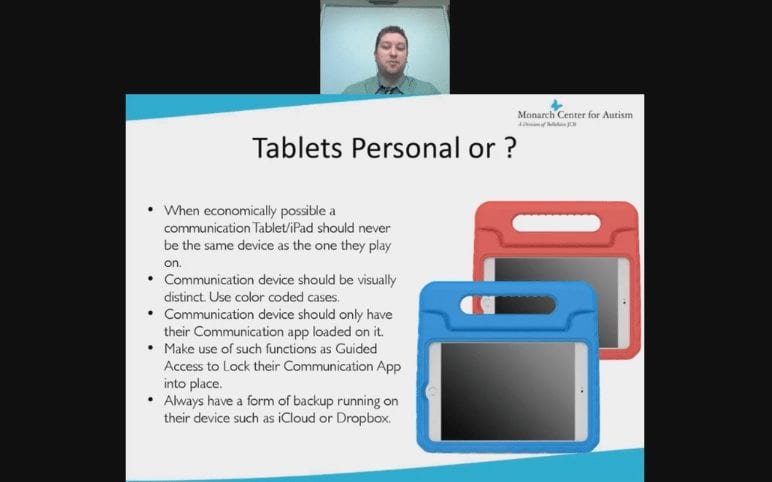Technology Holds Great Promise for Individuals on the Autism Spectrum
Research indicates that due to a heightened interest in visual materials combined with strong visual processing capabilities, many individuals with autism are attracted to and benefit from using technology. From devices, to apps, to smart home implementations, technology can help improve daily life for those on the autism spectrum immensely, and software and devices that are currently in development offer great promise for the future. In a recent edWebinar, Christian Karter, MA, Educational Technology Specialist at Monarch Center for Autism, reviewed the benefits of some of this helpful technology.
Augmentative and alternative communication (AAC) is some of most prevalent technology right now for individuals with autism. AAC can supplement or replace speech or writing, and allows individuals to use technology to help them communicate. Using a tablet with a communication app loaded onto it is a common way to do this. If the individual is also using a tablet for personal use or play, Christian recommends using two tablets if it’s economically possible—one for personal and one for communication—or only using the tablet for communication purposes.
Proloquo2Go, a symbol-based communication app, is an option for those interested in AAC. Story Creator is not specifically an AAC app but allows a user to create simple social stories which can be helpful for communication and interaction. The app Social Detective teaches users to use their different social skills to investigate clues. For families of individuals with autism, the online training website lynda.com may be helpful for learning how to use tablets and other devices. And, since some apps may be on the pricier side, Christian uses the websites appadvice.com and iosnoops.com to track app prices.
Other technology can transform your house into a smart home and create a safer and more interactive environment depending on the needs of the individual. Automatic door locks, motion detectors, cameras, or room-to-room audio and communication can provide added security as well as peace of mind for families. While not a security measure, smart lights can be a helpful visual tool to implement within the home. Philips Hue is one brand that can change the color of lights with the time of day. For example, purple lights to symbolize when it’s time for bed.
There are constantly new technologies on the horizon offering even more potential benefits than what already exists. With virtual reality, individuals can practice having an experience without needing to be in a stressful situation. ViTA DMF is creating software to do this with virtual job interviews. Augmented reality devices can be used to gain more information about the surrounding environment. Intel’s Vaunt or Microsoft’s HoloLens are smart glasses which will provide the individual wearing the glasses with more information about objects and locations.
The Fraunhofer Institute for Integrated Circuits is developing software that will help with detecting emotions, which could be beneficial for individuals with autism that may struggle with detecting emotions in others or feeling out situations. Brain Power is using their program, Transition Master, to help individuals transition to a new place before actually going there, and Face2Face, to help improve interaction and eye contact which is also a challenge for some, by turning regular conversations into games. Whether as simple as an app or intricate as virtual or augmented reality programs, technology can help to improve what can be an otherwise challenging daily life for those on the autism spectrum.
This broadcast was hosted by edWeb.net and sponsored by Monarch Center for Autism, STAR Autism Support, and VizZle.
This article was modified and published by eSchool News.
About the Presenter
Christian Karter, M.A. is the educational technology specialist at Monarch Center for Autism, a division of Bellefaire JCB, in Shaker Heights, Ohio. He holds a master’s degree in community counseling and a bachelor’s degree in psychology, both from John Carroll University. He has worked at Monarch Center for Autism for 11 years as an associate teacher in the classroom and in his present role. Christian’s chief responsibilities include iPad deployment, Monarch’s PAIRS Data System management, and introduction of new technologies into the classrooms.
Join the Community
Teaching Students with Autism is a free professional learning community that provides ideas and resources for teachers working with students with autism, particularly advances in technology that can lead to significant breakthroughs in communication and learning.








Comments are closed.